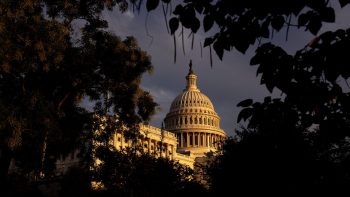
What lawmakers are fighting over when they fight about appropriations
What lawmakers are fighting over when they fight about appropriations

Congress is in the midst of its annual spending fight, with the House and the Senate working to reconcile their different spending bills. Ideally, the two chambers reach a compromise by the end of September, avoiding a government shutdown.
But despite the volume and intensity of this fight every year, the actual portion of federal spending being determined by what’s called the appropriations process is relatively small.
The federal government spends more than $6 trillion in a given year in two categories: mandatory and discretionary.
And that discretionary spending is “probably roughly in the neighborhood of a third [of the budget], of which a bit more than half is defense,” said David Reich, a senior fellow at the Center on Budget and Policy Priorities. “And a little bit less than half is everything else, which we call nondefense.”
So what Congress is fighting over now is roughly just one-half of that one-third of the federal budget — nondefense discretionary spending.
“It’s the National Weather Service. It’s the air traffic control system. It’s the IRS,” Reich said. “National Park Service and the Forest Service and those agencies.”
And all of these things are supposed to be included in 12 separate appropriations bills that go through each chamber of Congress, said Laura Blessing, a senior fellow at Georgetown University’s Government Affairs Institute.
But, “the formal federal appropriations process is broken. We have really diverged from both the timelines and the process in so many different aspects,” Blessing said, pointing to the fact that Congress hasn’t followed procedure to pass the 12 bills in the prescribed fashion in over a decade.
“We have seen continuing resolutions, or CRs. CRs used to be seen as a sign of failure not they’re now seen as a sign of success, which is extraordinarily telling,” she said.
And adding to the intensity of this dysfunction, the portion of the budget being controlled by this process is shrinking, according to Maya MacGuineas, president of the Committee for a Responsible Federal Budget.
“The discretionary portion of the budget has been being squeezed over time … due to the aging of the population and high health care costs. So Social Security, Medicare, Medicaid — they are all growing faster than the overall economy and the overall budget, and they’re putting pressure on the other areas,” she said.
Politicians don’t want to touch those popular programs and are often hesitant to limit the growth of defense spending. Plus, there’s the other part of mandatory spending — interest on the national debt.
“Right now, we spend more on interest payments than we do at the federal level for all spending on children, anyone under 18,” MacGuineas said. “That means we are spending more to finance the borrowing of the past than investing in the next generation in the future.”
While she agrees fiscal responsibility is important when it comes to the annual spending bills, she said politicians often spend most of their energy on the smallest slice of the budget, simply because it’s the easiest to cut.
There’s a lot happening in the world. Through it all, Marketplace is here for you.
You rely on Marketplace to break down the world’s events and tell you how it affects you in a fact-based, approachable way. We rely on your financial support to keep making that possible.
Your donation today powers the independent journalism that you rely on. For just $5/month, you can help sustain Marketplace so we can keep reporting on the things that matter to you.


















